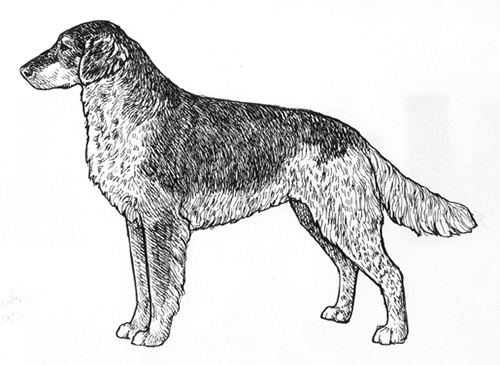Epagneul Picard
Gun Dog Group
The goals and purposes of this breed standard include: to furnish guidelines for breeders who wish to maintain the quality of their breed and to improve it; to advance this breed to a state of similarity throughout the world; and to act as a guide for judges.
Breeders and judges have the responsibility to avoid any conditions or exaggerations that are detrimental to the health, welfare, essence and soundness of this breed, and must take the responsibility to see that these are not perpetuated.
Any departure from the following should be considered a fault, and the seriousness with which the fault should be regarded should be in exact proportion to its degree and its effect upon the health and welfare of the dog and on the dog’s ability to perform its traditional work.
History
The Picardy Spaniel is descended from the old French spaniels that were crossed with English Setters and Gordon Setters. In 1921 the Picard Spaniel and Blue Picardy Spaniel Club was formed.
The Epagneul Picard was recognized by the United Kennel Club January 1, 1996.
General Appearance
A strong dog with a broad back and strong, well boned legs. The breed has gay head carriage, a gentle expression and very well constructed forequarters.
Characteristics
Gentle, intelligent and willing to please, very adaptable and possessing a strong natural hunting instinct.
Head
SKULL
Wide and rounded, with a prominent occiput. The stop is sloping, not abrupt.
MUZZLE
The muzzle is long and wide, tapering from the eyes to the nose. The nasal bridge is slightly arched. The lips are of medium thickness and slightly let down but not hanging.
TEETH
The Epagneul Picard has a complete set of evenly spaced, white teeth meeting in a scissors bite.
NOSE
Medium sized and brown in color.
EYES
Well opened, dark amber in color with a frank, friendly expression.
EARS
Set on rather low, framing the face and covered with beautiful silky, wavy hair.
Neck
Muscular, and well set into the shoulders.
Forequarters
The shoulder blade is rather long and somewhat upright. The upper arm is well muscled.
FORELEGS
The forelegs are straight, well muscled and feathered.
Body
The chest is deep and sufficiently wide, reaching down to the level of the elbows. The topline slopes gently from the withers to the hip bones. The loin is straight, wide and full. The croup is rounded, and slightly sloping. The flanks are flat and deep with slight tuck up.
Hindquarters
The haunches are prominent.
HIND LEGS
Straight, long, broad and well muscled. The hocks are slightly bent and the rear pasterns are straight. The hind legs are well feathered.
Feet
Round, large and tight, with a little feathering between the toes.
Tail
Set on not too high, hanging down in two slight curves, convex and concave. The tail is not too long and is furnished with silky feathering.
Coat
Dense and not too silky, fine on the head, and slightly wavy on the body.
Color
Brown roan with brown patches on various parts of the body and at the tail root, generally with tan markings on the head and legs.
Height
Height at the withers is 21.5 to 23.5 inches, with a tolerance of up to 24.5 inches for males.
Disqualifications
(A dog with a Disqualification must not be considered for placement in a conformation event, and must be reported to UKC.)
Unilateral or bilateral cryptorchid.
Viciousness or extreme shyness.
Albinism.

Looking for a Dog?
Find a dog that will fit your family.
Note: The breeders on this list are not endorsed by UKC.
©Copyright 1996, United Kennel Club
